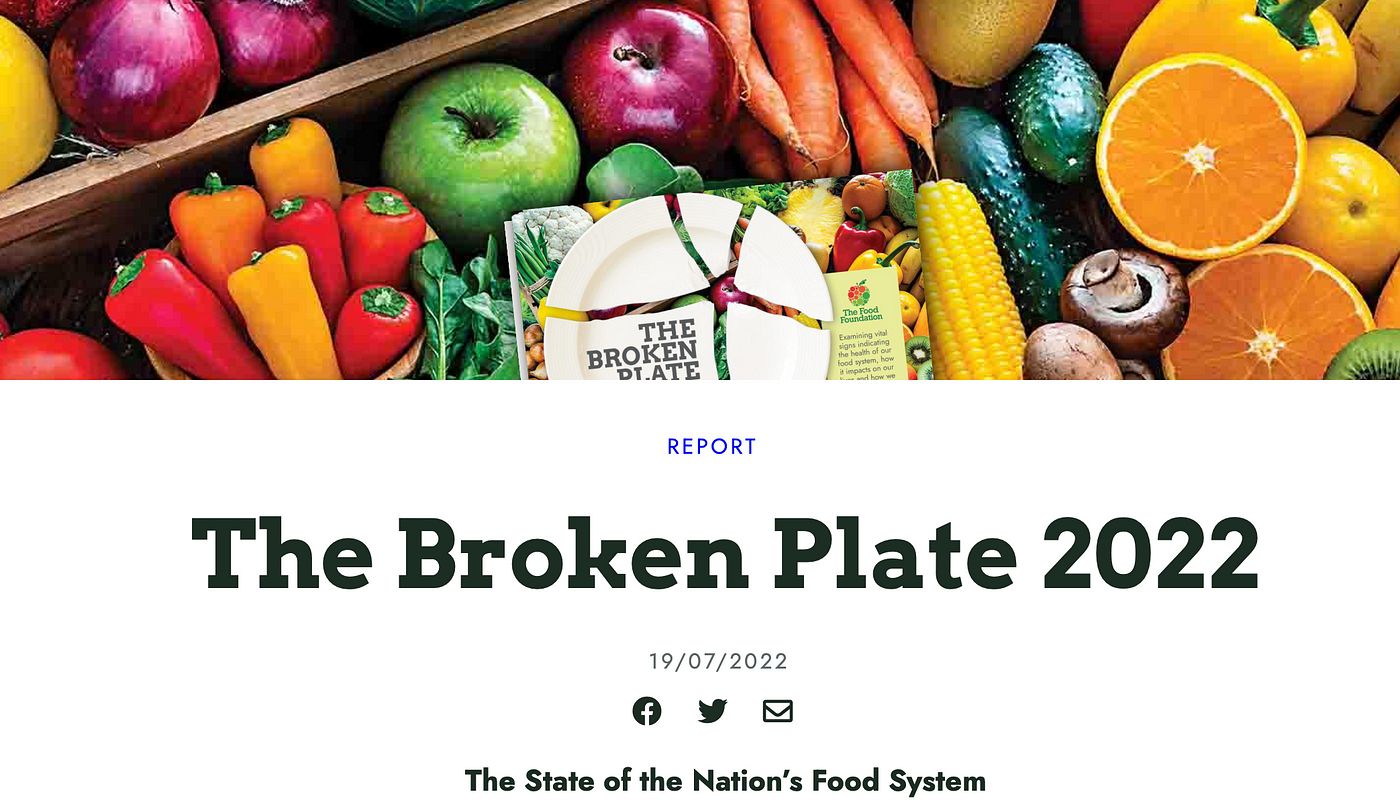A review of the week’s plant-based nutrition news 31st July 2022
This week I cover the the impact of lifestyle factors and type 2 diabetes on the risk of cognitive decline, the importance of fibre for improving health outcomes and some depressing data on the state of our food system in the UK.

PHYSICAL ACTIVITY AND DIET FOR OPTIMISING BRAIN HEALTH: The latest estimates suggest that 40% of cases of dementia could be prevented or significantly delayed by addressing lifestyle and socioeconomic factors. The current study analysed the impact of both physical activity (PA) and fruit and vegetable (F&V) consumption on brain health in participants of the Taiwan Longitudinal Survey on Ageing.
4440 participants over 53 years old in 1999 were included and cognitive function was assessed 5 times during the 16 year follow-up although this was self reported rather than being assessed by a physician. Dietary and physical activity data were assessed only at baseline. High (F&V) consumption was considered as >10 times per week and high PA was considered 6 times per week of more than 30 minutes, with sweating and gasping. The population studied appeared healthier than most Western populations given that round 50% of participants were in the high PA group and around 80% in the high (F&V) consumption group.
The results showed that high PA and F&V intake were independently associated with a decreased risk of 60% and 40% in cognitive decline, respectively. When combined, high PA and F&V intake significantly reduced the risk of cognitive decline by up to 63%. These results were significant after adjusting for other lifestyle, socioeconomic and disease-related factors. The study authors advocate for more emphasis on health behaviours given that ‘These personal actions are safe, effective, and economical approaches to health promotion and disease prevention’.
Given the lack of treatments for dementia, prevention is key. You can read my latest article on diet, lifestyle and brain health here.

TYPE 2 DIABETES AND COGNITIVE DECLINE: This is a sobering paper. Not only is the incidence and prevalence of type 2 diabetes rising, but so are rates of dementia globally. In the UK, 1 in 10 people over the age of 40 years are now living with type 2 diabetes. The two conditions are intimately connected given the shared mechanisms of disease development, namely dyslipidaemia, inflammation, dysbiosis (unhealthy gut microbiome) and insulin resistance.
This paper utilised neuroimaging and cognitive data on 20,314 participants of the UK Biobank study. Participants were between the ages of 50 and 80 years with 1012 having type 2 diabetes and and 19,302 healthy controls. The median duration of diabetes was 8.5 years (0–31 years). The results showed that a diagnosis of type 2 diabetes was associated with marked cognitive deficits, particularly in executive functioning and processing speed. In addition, a diagnosis of diabetes was significantly associated with structural changes, including brain atrophy. These structural and functional changes associated with diabetes overlap with the effects of ageing but appear earlier, with longer duration of type 2 diabetes associated with more severe neurodegeneration. The negative impact of type 2 diabetes was found to be more severe in males than females. This may be due to the protective effect of female hormones, such as oestrogen, on brain health prior to the menopause. The impact of diabetes treatment, specifically metformin, was assessed and not shown to improve neurocognitive outcomes. However, data was not available to assess the impact of the degree of diabetes control (i.e. HbA1C levels) on neurocognitive outcomes
A further meta analysis of 34 studies was conducted with 4735 participants diagnosed with type 2 diabetes and 17,496 healthy controls and the results confirmed the findings of the UK Biobank analysis. The authors conclude ‘our results suggest that type 2 diabetes and its progression may accelerate pathways associated with typical brain ageing’

FIBRE INTAKE AND HEALTH OUTCOMES: This is an excellent review of the role of fibre consumption for improving health outcomes with a recommendation that health professionals should support their patients to consume a variety of healthy plant foods. My only disappointment is that the review is framed around fibre rather than discussing the benefits of a plant-based diet in general, which of course includes adequate fibre consumption, plus an array of other benefits. Nonetheless, being in the BMJ and open access will give the article excellent visibility and ultimately the overall message is that we need to be shifting to a more plant-based diet.
The review reminds us that fibre is not just a single nutrient but in fact there are difference types of fibre, which have different impacts on the body. The basic divisions are soluble and insoluble fibre. Soluble fibres can form a viscous gel and contribute to delayed gastric emptying, lowering cholesterol and improved glycaemic control. Some soluble fibres are fermentable and broken down by gut bacteria and hence called prebiotics. Insoluble fibres contribute to increasing intestinal transit time and keeping the stool soft. In general, however, all types of fibre can contribute to improving the health of the gut microbiota and increased production of short chain fatty acids by healthy gut bacteria, which are associated with an array of health benefits. Of note, isolated and synthetic fibres are often added to foods and the review reminds us that even these types of fibre have been associated with health benefits, albeit different from those found in whole foods.
The review lists the known benefits of increasing fibre consumption, including a reduction in the risk of coronary heart disease, cardiovascular disease, stroke, type 2 diabetes, inflammatory bowel disease, colorectal cancer plus reduction in all-cause, cardiovascular and cancer mortality.
The overall actionable recommendations are to include a variety of healthy plant foods in the diet including legumes, vegetables, whole grains and fruit with daily consumption of chia and flax seeds being a good addition. Foods with ≥3 g of fibre per 100 g, ≥1.5 g per 100 kcal, or ≥10% of daily reference value per serving can be named a “good source of fibre.” If twice as much fibre is present, they can be called “high fibre”.
The authors acknowledge, ‘Strong evidence from observational studies shows that populations with a large proportion of plant-based, fibre-rich diets (vegans, vegetarians) or those whose dietary patterns are characterised as being high in plant foods have greater protection against developing chronic disease’

THE STATE OF THE FOOD SYSTEM IN THE UK: This annual report from the Food Foundation makes for very sad reading. Healthy diets remain inaccessible and unaffordable to those that need them the most. The food system is not meeting our health or climate needs. Back in 2021, the National Food Strategy for England identified four key areas where dietary shifts were needed to ensure a healthy and sustainable future: increased consumption of fibre, and fruit and vegetables; and decreased consumption of meat, and high fat, salt and/or sugar (HFSS) foods. Yet more than a year later, the situation has only worsened. Here are the headline messages from this years report.
- The poorest fifth of UK households would need to spend 47% of their disposable income on food to meet the cost of the Government-recommended healthy diet. This compared to just 11% for the richest fifth.
- 22% of workers in the food system earn the National Minimum Wage or below, compared to 8% of workers across the whole UK economy.
- More healthy foods are nearly three times as expensive per calorie as less healthy foods.
- More sustainable alternative milks are approximately 60% more expensive than dairy milk.
- School food standards are not adequately monitored and school children are experiencing food insecurity.
- More than 1 in 4 (26%) places to buy food are fast-food outlets.
- 71% of sandwiches available from high street retailers contain meat or fish, with no significant improvement in the last 3 years.
- Only 7% of breakfast cereals and 4% of yogurts marketed to children are low in sugar. Approximately a third (32%) of food and soft drink advertising spend goes towards less healthy foods, compared to just 1% for fruit and vegetables.
- The percentage of children with obesity in their first year of school has risen by 50% in one year, affecting twice as many children in the most deprived fifth compared to the least deprived fifth.
- Nearly 10,000 amputations are carried out for type 2 diabetes every year, an increase of 23% in 5 years.
- Healthy life expectancy in the most deprived tenth of the population is 20 years less for women and 18 years less for men than in the least deprived 10th.
- If current trends continue then, amongst children born this year, 1 in 4 will suffer overweight or obesity by the time they start school, rising to 3 in 4 by age 65.
- If things continue as they are, by 2050 emissions from the food system will be four times higher than the level that is needed if the UK is to meet its net zero target.
The recent UK Government food strategy published in June 2022 fails to address most of these issues, which makes me feel pretty hopeless. We need to do better for our health and the health of the planet.

QUALITY OF SCHOOL MEALS: This study confirms problems identified in the Broken Plate report. The study aimed to determine the ultra-processed food (UPF) content of school food in the UK. The researchers performed a cross-sectional analysis of primary (4–11 years, n = 1895) and secondary school children (11–18 years, n = 1408) from the UK’s National Diet and Nutrition Survey (2008–2017). The results showed that on average, UPF intake was high in both primary (72.6% total lunch Kcal) and secondary school children (77.8% total lunch Kcal). Higher UPF intakes were observed in packed lunch consumers, secondary school children, and those in lower income households. The authors conclude ‘This study highlights the need for a renewed focus on school food’.
Ultra-processed food consumption is a problem for all diet patterns. The consumption of these foods really do negatively impact health outcomes. Even at relatively low levels of consumption, there is a measurable increase in the risk of premature death as highlighted by this recent paper. This excellent factsheet highlights the extend of the problem globally, the health impacts associated with the consumption of ultra-processed foods and what needs to be done to address the problem.
Luckily, in the UK, we have the fantastic School Plates initiative run by Proveg that is supporting schools to incorporate healthy plant-based meals into their menus. The project has been hugely successful. This year sees the first UK school to adopt a fully plant-based/vegan menu. Similar initiatives are cropping up around the world, so may be this is an area for which we can be more hopeful.
Please follow my organisation ‘plant-based health professionals UK’ on Instagram @plantbasedhealthprofessionals and facebook. You can support our work by joining as a member or making a donation via the website.
